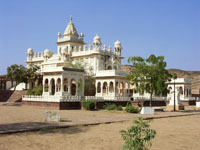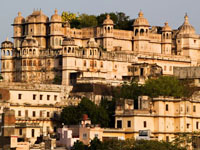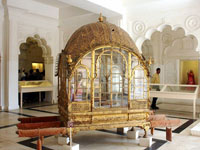| |
|
| |
Wild Desert Resort |
|
|
|
|
|
|
| |
 |
|
| |
| |
An Adventure on sand dunes and same. get a feel of shifting sand dunes Capturing the spirit of Sand Dunes and ensuring the perfect Dunes experience at Wild desert resort, a unique Sam Dunes Resort and Camp. |
|
|

|
|
|
|
|
|
|
| Place to Visit Jodhpur-Rajasthan |
 Jodhpur is located in the western region of Rajasthan and at the edge of the Thar Desert. Jodhpur is the second largest city of the state. Wander around and explore the fascinating region with historical monuments. Learn more about the legendary past of Jodhpur with the tour of historical places ofJodhpur - Rajasthan Jodhpur. There are numerous tourist attractions of Jodhpur that has historical significances. Mehrangarh Fort is a 5 km long fort and has four gateways. The fort stands on a 125 m high hill.Built in 1899 AD, Jaswant Thada showcases the magnificent work of white marble. Cheetar Palace (Umaid Bhawan Palace) is a 20th century structure. It took 16 years to complete the construction of the palace. A part of the palace has now been converted into aheritage hotel and another part houses a museum. Girdikot and Sardar Market is one of the oldest markets of the region. You can buy colorful handicraft from here. Government Umaid Museum houses rare paintings, weapons, sculptures and artifacts. A tour to Jodhpur never disappoints any travelers. Jodhpur is located in the western region of Rajasthan and at the edge of the Thar Desert. Jodhpur is the second largest city of the state. Wander around and explore the fascinating region with historical monuments. Learn more about the legendary past of Jodhpur with the tour of historical places ofJodhpur - Rajasthan Jodhpur. There are numerous tourist attractions of Jodhpur that has historical significances. Mehrangarh Fort is a 5 km long fort and has four gateways. The fort stands on a 125 m high hill.Built in 1899 AD, Jaswant Thada showcases the magnificent work of white marble. Cheetar Palace (Umaid Bhawan Palace) is a 20th century structure. It took 16 years to complete the construction of the palace. A part of the palace has now been converted into aheritage hotel and another part houses a museum. Girdikot and Sardar Market is one of the oldest markets of the region. You can buy colorful handicraft from here. Government Umaid Museum houses rare paintings, weapons, sculptures and artifacts. A tour to Jodhpur never disappoints any travelers.
Located amidst the thorny vegetation and brittle yet awesome sand dunes, lies a grand fort above 120 meters. The city of Jodhpur is surrounded by 10-km long wall with eight gates. Here you can see a multitude of palaces, forts, temples and havelis, all celebrating the grandeur of Rajasthan.
Observe the city flourishing with traditional lifestyle and festivity throughout the year. The city has an extreme type of climate with temperature range variation being very high.
Chipko Movement to Save Tree
Thakur Surat Singh, of Kharda thikana, a small estate in Jodhpur
pargana. was granted the estate of Khejarli in the same pargana, by
Maharaja Abhai Singh of Jodhpur in 1726 AD, and he became the first
'Thakur of Khejarli' [5], though tragedy struck the village within
four short years.
Cenotaph of Bishnoi martyrs at Khejarli,who laid down their lives in
1730 AD protecting trees
It is the place where Chipko movement originated in India. It was a
Tuesday, black Tuesday in Khejadli. 10th day of the bright fortnight
of the month Bhaadra according to Indian lunar Calendar, (September)
in 1730 A.D. Amrita Devi a mother of three daughters viz. Asu, Ratni
and Bhagu bai was at home with her daughters. Suddenly, she came to
know that many people had descended in their otherwise sleepy village.
It was a party of Giridhar Bhandari, a minister with Maharaja Abhay
Singh, Ruler of Marwar (Jodhpur) state who wanted to fell the sacred
green Khejri (Prosopis cineraria) trees to burn lime for the
construction of his new palace. Since there was a lot of greenery in
the Bishnoi villages even in the middle of Thar Desert, the king
ordered his men to get the woods from Khejri trees.
Amrita Devi sacrifices for saving trees
Amrita Devi (Beniwal) protested against King's men attempting to cut
green trees as it was prohibited in Bishnoi religion. The malevolent
feudal party told her that if she wanted the trees to be spared, she
should give them money as bribe. She refused to acknowledge this
demand and told them that she would consider it as an act of ignominy
and insult to her religious faith. She said that she would rather give
away her life to save the green trees. It is at that stage she spoke
these words:
Devanagari:"Sar sāntey rūkh rahe to bhī sasto jān" (If a tree is saved
even at the cost of one's head, it's worth it) [6]
Saying these words, she offered her head. The axes, which were brought
to cut the trees, severed her head from her trunk. The three young
girls Asu, Ratni and Bhagu were not daunted, and offered their heads
as well, and met the same end.\ Art By Vignesh The Prince
Mass movement to protect trees
The news spread like wildfire. Bishnois gathered and sent summons to
83 Bishnoi villages to come and decide on the next course of action.
Since the supreme sacrifice by those four had not satisfied the royal
party, and the felling of green trees was continued, it was decided
that for every green tree to be cut, one Bishnoi volunteer would
sacrifice his/ her life. In the beginning, old people voluntarily
started holding the trees to be cut in an embrace as in the Chipko
movement of 20th century in Uttar Pradesh (India).
 Mehrangarh Fort Mehrangarh Fort
Situated on a steep hill, Mehrangarh fort is one of the largest forts in India. The beauty and the grandeur of numerous palaces in the fort narrates a saga of hard sandstones yielding to the chisels of skilled Jodhpuri sculptures.
History of Jodhpur
Rao Jodha, the chief of Rathore clan of Rajputs, founded Jodhpur in the year 1459 A.D. Situated on the edge of the vast Thar Desert, Jodhpur echoes with the heroic and historical tales of various kings and queens. Once, a major trade centre in the 16th century A.D, Jodhpur is now considered to be 'the second largest city' of Rajasthan Lying on the strategic Delhi-Gujrat trading route, Jodhpur made people benefit from the traffic of opium, copper, silk, dates and coffee. Explore the history of Jodhpur during Jodhpur Travel
Mughal emperor Akbar was also not left untouched by the growing richness of Jodhpur; he ensured an alliance with the Rathore clan by marrying the sister of Rao Udai Singh. The history of Jodhpur includes the old city of Jodhpur that is fenced with a 10 km long wall with 8 Gates leading out of it and the new city that is situated outside the walled old city. Sir Pratap Singh, son of Maharaja of Jodhpur laid the foundation of modern Jodhpur.
Places must see...
Government Museum - Jodhpur
This museum has a rich collection of weapons, textiles, miniature portraits, local crafts and images of Jain Tirthankars. It is situated in the middle of the Umaid public gardens.
Marwar Festival
Marwar Festival is held every year in memory of the heroes of Rajasthan. The festival is held in the month of Ashwin (September-October) in Jodhpur, for two days during the full moon of Sharad Poornima.
Umaid Bhawan Palace
The only palace built in 20th century under the famine relief programme, has now been converted into a hotel with some parts being retained as a museum.
Mehrangarh Fort Museum
 This is an excellent museum with rare and interesting artifacts, textiles, painting transport items etc laid out with utmost care and thought. The Palanquin Gallery and Howdah Gallery display a superb collection of old and costly specimens of great historical value. This is an excellent museum with rare and interesting artifacts, textiles, painting transport items etc laid out with utmost care and thought. The Palanquin Gallery and Howdah Gallery display a superb collection of old and costly specimens of great historical value.
Clock Tower & Sadar Market
In the old city, clock tower is a prominent land mark. But main attraction is the Sadar Market. The market has kept alive the old 'haat bazaar' culture.
Jaswant Thada
The 19th century royal cenotaph is built in white marble, in commemoration of Maharaja Jaswant Singh. Some rare portraits of the rulers of Jodhpur are also displayed here.
Umaid Bhawan Museum
Recently the ruling family of Jodhpur has converted a part of the gigantic Umaid Bhawan Palace as the palace museum.
Excursions from Jodhpur
Mandore (8Km.)
Situated 9-kms north of the city of Jodhpur, is Mandore which, was the capital of Marwar prior to the foundation of Jodhpur.Today, its extensive gardens with high rock terraces make it a popular local attraction. The gardens also contain the cenotaphs of Jodhpur rulers.
Ossian (65Km.)
65-km from Jodhpur, lie ruins of an ancient city called Ossian. This city is famous for Brahmanical and Jain temples, which belong to 8th and 11th century.
Sardar Samand Lake (55Km.)
 Nestled in the vicinity of the city of Jodhpur, is the astoundingly scenic Sardar Samand Lake. The lake lies 60-kms south-east of Jodhpur off the Jodhpur-Pali route. Nestled in the vicinity of the city of Jodhpur, is the astoundingly scenic Sardar Samand Lake. The lake lies 60-kms south-east of Jodhpur off the Jodhpur-Pali route.
Balsamand Lake & Palace (7Km.)
This picturesque artificial lake is 7 kms from the main city. Summer palaces along the embankment and a bird sanctuary has made it a picnic spot.
Fairs & Festivals - Jodhpur
The Marwar Festival - Held in October, this festival brings alive the legend, folklore and romantic lifestyle of Rajasthan's rulers.
How To Get There - Jodhpur
By Rail
The city is also well connected by the railway lines and trains are available for other major cities in the country from here. The 'Palace on Wheels' also visits this city of royal splendour.
By Air
Jodhpur has its own airport and regular flight services conect the city with other major cities in and around Rajasthan.
By Road
The state transport has bus services from other cities of the state and some services are interstate too.
Places To Stay - Jodhpur
The variety of hotels and guest houses in Jodhpur makes one feel at home. Accommodation here is available to suit tourists of every budget. Hotel Karni Bhawan, Ajit Bhawan are heritage hotels. The Rajasthan Tourism Department has the Ghoomar Hotel. The palace hotels options include theUmaid Bhawan Palace, Ratanada Polo Palace, Rajputana Palace. Raj Basera also provides good accommodation facilities. There are low budget accommodations avaialable too.
Shopping - Jodhpur
Where to Shop in Jodhpur
The Sadar Market near the Clock Tower gives immense shopping pleasure to the locals as well as the visitors. The colourful but hectic bazaar consists of many narrow lanes, lined with tiny shops. Look for the tie & dye textiles, embroidered leather shoes, lacquerware, antiques, carpets and puppets. Here, one can buy exquisite Rajasthani textiles, clay figurines, miniature camels and elephants, marble inlay work and classic silver jewellery
The city comes alive with...
The best season to visit the city is between October and March when the weather is pleasant and enjoyable.
|
|
|


